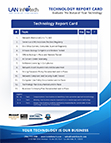Making Ongoing Risk Management an Operational Standard
No business today is 100 percent secure from cyberthreats. Every day, more businesses are waking up to this reality, finally understanding the importance of a good cybersecurity system. It’s no wonder cybersecurity investment in 2020 was pegged to grow by 5.6 percent to reach nearly $43.1 billion in value.1 With cyberattacks surging, due to widespread remote work and increased online interactions during the pandemic, it seems likely that this trend will only continue to grow.
While 58 percent of IT leaders and practitioners consider improving IT security their topmost priority, nearly 53 percent of them find cybersecurity and data protection to be among their biggest challenges as well.2 That’s primarily because cybersecurity is not a one-and-done exercise. Your business might be safe now, but it could be unsafe the very next minute. Securing your business’ mission critical data and the data of your invaluable clients/customers requires undeterred effort sustained over a long period of time. While there are several pieces to this puzzle, the most important one, considering today’s threat landscape, is ongoing risk management.
Through the course of this blog, you will understand the definition of a cybersecurity risk assessment, and why you must undertake and monitor them regularly to keep your business’ cybersecurity posture abreast with ever-evolving cyberthreats. By the end of it, we hope you realize how installing cybersecurity solutions alone isn’t enough to counter cyberattacks. It also requires making ongoing risk management an operational standard for your business.
Understanding Cybersecurity Risk Assessment
In rudimentary terms, a cybersecurity risk assessment refers to the act of understanding, managing, controlling and mitigating cybersecurity risks across your business’ infrastructure.
In its Cybersecurity Framework (CSF), the National Institute of Standards and Technology (NIST) states that the purpose of cybersecurity risk assessments is to “identify, estimate and prioritize risk to organizational operations, assets, individuals, other organizations and the Nation, resulting from the operation and use of information systems”. This means that cybersecurity risk assessments are the key to finding the holes in your current cybersecurity system
The primary purpose of a cybersecurity risk assessment is to help key decision-makers make informed choices to tackle prevalent and imminent risks. It requires having a clear understanding of where your business is at currently, and where it needs to be going. Ideally, an assessment must answer the following questions:
- What are your business’ key IT assets?
- What type of data breach would have a major impact on your business?
- What are the relevant threats to your business and their sources?
- What are the internal and external security vulnerabilities?
- What would be the impact if any of the vulnerabilities were exploited?
- What is the probability of a vulnerability being exploited?
- What cyberattacks or security threats could impact your business’ ability to function?
The answers to these questions will help you keep track of security risks and mitigate them before disaster strikes. Now, imagine periodically having the answers to these questions whenever you sit down to make key business decisions. This would dismiss any doubts you have about your business’ needs. You don’t have to wonder what is required to stay safe or what is missing, because you will already have all the data you need to make the right choice.
Why Make Ongoing Risk Management an Operational Standard?
Making ongoing risk management an operational standard is vital, especially in today’s cyberthreat landscape where even a single threat cannot be underestimated. You never know when you may be targeted. And you do not know how much damage that attack will cause until after it has already happened. That is of course, unless you are doing regular assessments. In one assessment, your business might seem on the right track, but in the next one, certain factors could have changed, causing your business to be less secure. That’s precisely why having an ongoing risk management strategy is now an integral part of standard operations for many modern businesses.
Here are seven reasons why you should start using ongoing risk management now:
Reason 1: Keeping Threats at Bay
Most importantly, an ongoing risk management strategy will help you keep threats, both prevalent and imminent, at a safe distance from your business; especially ones you usually do not monitor. If there is a threat you do not track regularly, you will be unaware of when you may be targeted. Ongoing risk management will help you know every threat that may come your way.
Reason 2: Prevent Data Loss
Theft or loss of business-critical data can set your business back a long way, leading to loss of business to competitors. Ongoing risk management can help you remain vigilant of any possible attempts at compromising your business data. In turn, this will prevent ransomware attacks, which are becoming more and more common and costly.
Reason 3: Enhanced Operational Efficiency and Reduced Workforce Frustration
As a business owner or key decision-maker for your organization, you would be amazed how consistently staying on top of potential cybersecurity threats can reduce the risk of unplanned downtime. The assurance that hard work will not vanish into thin air will surely keep the morale of your employees high, thereby reflecting positively on their productivity. It also sends the message that the company is secure and will continue to succeed in the future.
Reason 4: Reduction of Long-Term Costs
Identifying potential vulnerabilities and mitigating them in time can help you prevent or reduce security incidents, which in turn would save your business a significant amount of money and/or potential reputational damage. Threats do not only cause direct loss of income, but also indirect losses based on the reputation of the organization, and how clients feel about your business.
Reason 5: One Assessment Will Set the Right Tone
You must not assume that there should only be one fixed template for all your future cybersecurity risk assessments. However, in order to update them continuously, you need to conduct one in the first place. Hence, the first few assessments will set the right tone for future assessments as part of your ongoing risk management strategy. You can also change what is done in the assessments to fit the ever changing needs of the business.
Reason 6: Improved Organizational Knowledge
Knowing security vulnerabilities across the business will help you keep a keen eye on important aspects that your business must improve on. Understanding your weak spots is necessary before any improvements can be made. Taking this step is important for the long term health of your business.
Reason 7: Avoid Regulatory Compliance Issues
By ensuring that you put up a formidable defense against cyberthreats, you will automatically avoid hassles with respect to complying with regulatory standards such as HIPAA, GDPR, PCI DSS, etc. If you are not compliant to these standards, you will be required to pay costly fines, further damaging the business.
Join Hands With the Right Partner
While we certainly wish we could say that you have plenty of time to mull over this, the unfortunate reality is you do not. If you snooze, it’s very likely that you will lose to a nefarious cybercriminal.
It’s time for you to join hands with the right partner to help you gauge every single cybersecurity risk your business is exposed to and protect your business continuously. Write to us today to find out how you can prevent cybersecurity concerns from harming your business.

LAN Infotech is a Microsoft Cloud Services Provider, IT Managed Support company and a leader in helping law firms, nonprofits and medical organizations deploy cloud solutions, manage computer networks, keep data protected and top technology management company. Businesses like yours need technology support to run highly-effective organizations.



